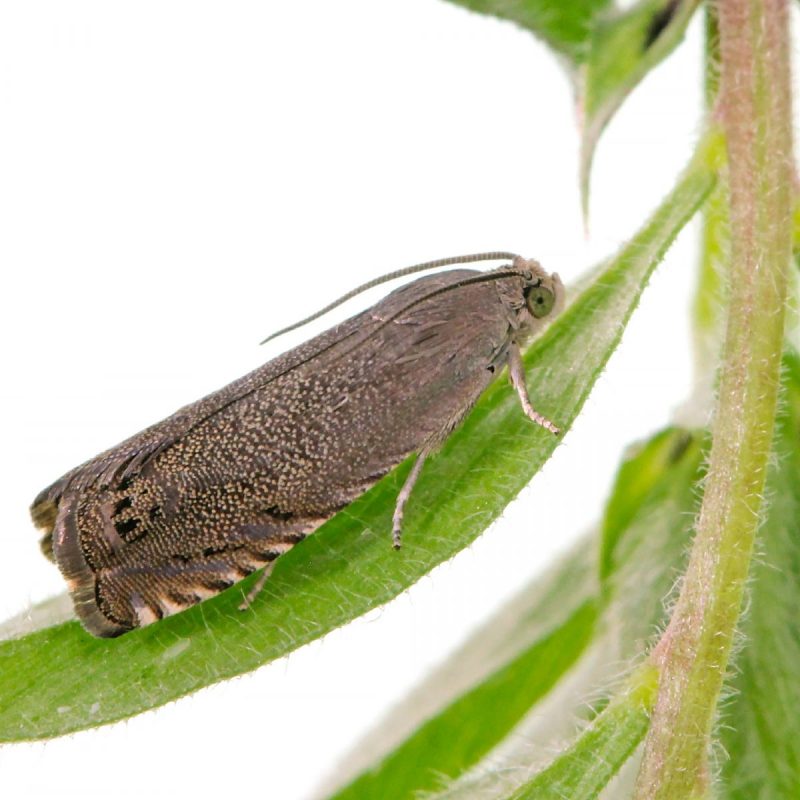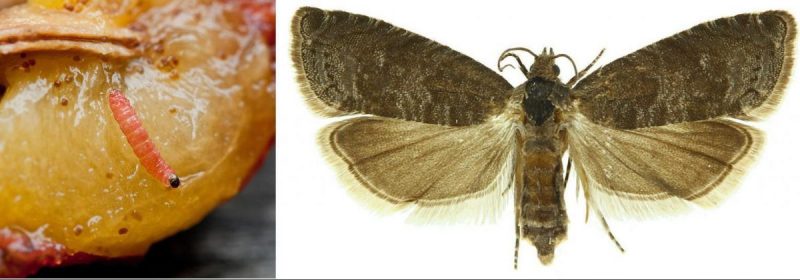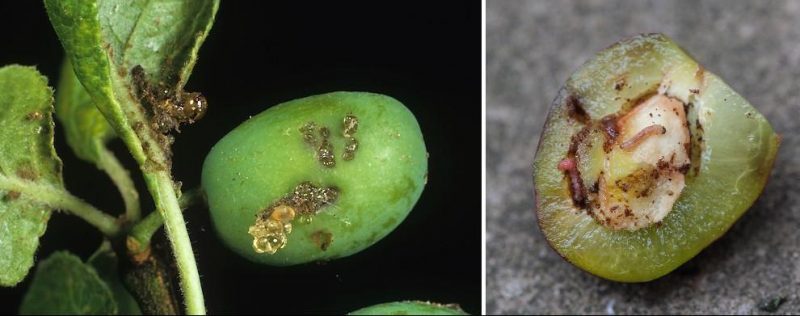The plum fruit moth (Cydia funebrana) – pest management

Prevalence. The plum fruit moth (Grapholita funebrana syn. Cydia funebrana) is widespread in most plum plantations in Europe, North America, North Africa, Asia, the Far East, and Australia.
Description. The adult is a small butterfly with a wingspan of 10-15 mm. The forewings are dark brown in color and have an oval, glossy, gray-brown, or leaden spot on the apex. The hind wings are gray with short, whitish fringes.
The egg is elliptical, translucent at first, then it turns yellow. The larva has a red-bricky color on the dorsal side and pale pink on the ventral side. It measures 10-14 mm in length when fully developed.
Biology and ecology
The plum fruit moth produces 2 generations per year, but it has been recorded that in the lowland areas it can develop a third generation.
This pest overwinters in the larva stage in a silky cocoon, in cracks in the bark of stems, under the bark, or in-plant remains. In spring, in March-April, the larvae turn into pupae. The first adults appear at the beginning of May (in the steppe and forest-steppe areas) or at the end of the month (in the oak and beech subarea) and become active at average temperatures above 10° C.
Mating takes place immediately after emergence, followed by egg-laying. From the 5-7 weeks in which the adults take flight, the females lay 40-80 eggs within a month. The eggs are laid on the underside of the leaves and especially on the young fruits. Incubation lasts between 6 and 8 days.
The larvae appear in galleries in the young fruits and feed on the raw pulp and seeds. As a result, the fruits stop growing, become purplish, and fall to the ground and the larvae continue to feed until full development after which they retreat under the exfoliated bark of the trunks and make their silky cocoon turn into pupae.
The appearance of the second generation butterflies follows, at the beginning of July. After the appearance, the adult’s mate and the females lay their eggs on the raw fruit or in the dough ripeness, preferring the late and semi-late varieties. The larvae of the second generation penetrate the fruit and drill galleries around the seed. Towards autumn, at the beginning of September, the larvae retire for overwintering, constituting the biological reserve for the following year.
Attacked plants and damages
Cydia funebrana attacks both wild and cultivated plum trees, as well as cherry, peach, and apricot trees. The attack consists in destroying the pulp and the seed of the fruit and filling them with droppings.
The larvae have a different mode of attack, depending on when they appear.
Thus, the larvae of the first generation attack the fruits in the peduncle’s area, they become purplish and fall prematurely. Following the attack of the larvae from the second generation, the fruits ripen prematurely, become soft, fall, and rot on the ground. These fruits show gummy leaks in the area of the hole through which the larva enters. Second-generation larvae cause the most damage, affecting up to 80% of the crop.
Control
As a measure to prevent and reduce the biological reserve of the pest, it is very important to gather the fallen fruit and destroy or use them for various purposes. Thus, the number of adults from the first generation and of the overwintering larvae that will produce infestations in the next year is considerably reduced.
Pheromone traps have been shown to be effective because they disorient and trap males, leaving females unfertilized.
Recommended products
-
You can find products on a different store
Change Store -
You can find products on a different store
Change Store -
You can find products on a different store
Change Store -
You can find products on a different store
Change Store -
You can find products on a different store
Change Store -
You can find products on a different store
Change Store -
You can find products on a different store
Change Store -
You can find products on a different store
Change Store -
You can find products on a different store
Change Store -
You can find products on a different store
Change Store -
You can find products on a different store
Change Store -
You can find products on a different store
Change Store -
You can find products on a different store
Change Store -
You can find products on a different store
Change Store -
You can find products on a different store
Change Store -
You can find products on a different store
Change Store -
You can find products on a different store
Change Store -
You can find products on a different store
Change Store -
You can find products on a different store
Change Store -
You can find products on a different store
Change Store -
You can find products on a different store
Change Store -
You can find products on a different store
Change Store -
You can find products on a different store
Change Store -
You can find products on a different store
Change Store
The plum fruit moth has natural pests and predators. Biopreparations based on Bacillus thurigiensis can be made with very good results. The parasitic wasp Trichogramma embryophagnum successfully destroys the eggs and the parasites Ascogaster quadridentatus and Ascogaster rufipes destroy the larvae.
A wide range of products is approved for chemical pest control. With the help of traps, the moment of application of phytosanitary products is established. Thus, when capturing 3-5 butterflies/trap/week (5 traps/ha), specific insecticide treatments must be performed immediately. For successful control, one treatment is recommended for each generation.
In the absence of these traps, treatments can be carried out from the flowering stage (with insecticides that protect the useful entomofauna) to the beginning of fruit ripening, with a break of at least 14 days between treatments.
When applying treatments during the dormancy period, you should insist on the bark at the base of the stem because it is a preferred place for larvae to overwinter.
The treatments have to be carried out with specific insecticides.
Recommended products
-
You can find products on a different store
Change Store -
You can find products on a different store
Change Store -
You can find products on a different store
Change Store -
You can find products on a different store
Change Store -
You can find products on a different store
Change Store -
You can find products on a different store
Change Store -
You can find products on a different store
Change Store -
You can find products on a different store
Change Store -
You can find products on a different store
Change Store -
You can find products on a different store
Change Store -
You can find products on a different store
Change Store -
You can find products on a different store
Change Store -
You can find products on a different store
Change Store -
You can find products on a different store
Change Store -
You can find products on a different store
Change Store -
You can find products on a different store
Change Store -
You can find products on a different store
Change Store -
You can find products on a different store
Change Store -
You can find products on a different store
Change Store -
You can find products on a different store
Change Store -
You can find products on a different store
Change Store -
You can find products on a different store
Change Store -
You can find products on a different store
Change Store -
You can find products on a different store
Change Store

















































































































































































































































































































































































































































